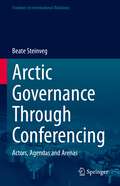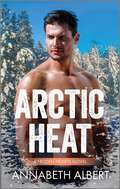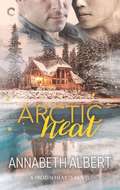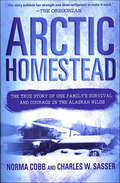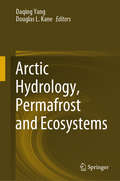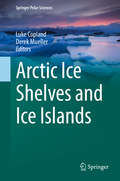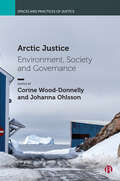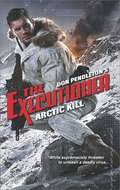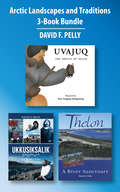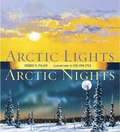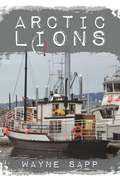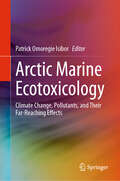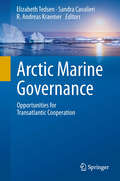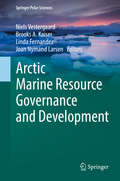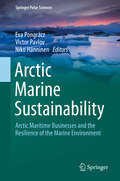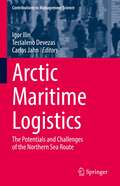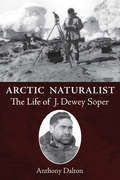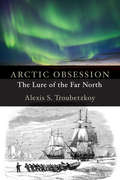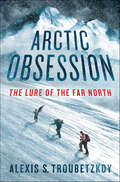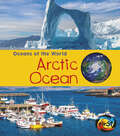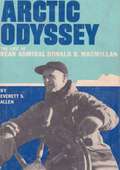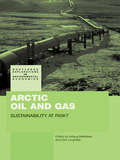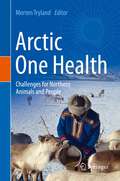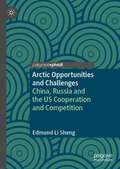- Table View
- List View
Arctic Governance Through Conferencing: Actors, Agendas and Arenas (Frontiers in International Relations)
by Beate SteinvegThis book examines the functions of conferences within Arctic governance, as a third dimension between sovereign states and formalized cooperative arrangements. It analyzes conferences against the background of three main empirical topics. Firstly, the functions of conferences for different actor groups, both Arctic rights holders and emerging non-Arctic state actors claiming stakeholder status. From this, the book also analyzes how conferences contribute to altering the actor composition of Arctic governance as a whole. Secondly, conferences as agenda setting arenas – whether conference activities can contribute to influencing the broader agenda in the region, and conferences as arenas for agenda setting – whether participants can bring with them topics that are picked up and brought into other processes. Thirdly, the book considers the space for conferences within broader governance architectures, as links between units in the regime complex.The book further presents an in-depth case study of the two largest conferences on Arctic issues: the Arctic Frontiers and Arctic Circle Assembly. It illustrates the diverse functions conferences can have for elements within a broader governance system, beyond serving as meeting places and networking arenas. Therefore, it is a must-read for researchers, students, and policy-makers interested in a better understanding of Arctic governance in particular, and International Relations in general.
Arctic Heat: A Forced Proximity LGBTQ Romance (Frozen Hearts)
by Annabeth AlbertA lasting connection needs more than simply surviving a winter together—they&’ll have to outsmart danger, let down their defenses and open their hearts.&“Whether making my heart melt or my head burst into flames, Annabeth Albert draws the reader in and keeps them captivated.&” —Gay Book ReviewsOwenI&’ve got a fresh lease on life—after kicking cancer&’s ass I&’m roaring through my bucket list. I left my life as an investment banker behind hoping to find my next challenge in Alaska, volunteering alongside park rangers and fulfilling my childhood dreams of snowy winters and rustic life. Of course, those dreams did tend to feature big strapping mountain men in vivid detail… men like Ranger Quilleran Ramsey.As the snowbound weeks pass and we give in to temptation, I can&’t help but wonder if our seasonal romance can last until spring?QuillI&’d rather be anywhere than dealing with newbie volunteers. The only thing I need less than a green volunteer &“partner&” is the flirty attentions of Owen Han, the buff city boy who doesn&’t look ready to last a week, let alone a whole Alaskan winter. We&’re all wrong for each other, if only my traitorous body didn&’t enjoy the flirting more than it should.We&’ll have to trust each other to ensure the harsh elements and omnipresent dangers don&’t destroy what happiness we&’ve found in the moment, and maybe even give us a chance at a future together.Previously published Frozen Hearts Book 1: Arctic Sun Book 2: Arctic Wild Book 3: Arctic HeatAlso by Annabeth Albert:Shore Leave Book 1: Sailor Proof Book 2: Sink or SwimOut of Uniform Book 1: Off Base Book 2: At Attention Book 3: On Point Book 4: Wheels Up Book 5: Squared Away Book 6: Tight Quarters Book 7: Rough Terrain
Arctic Heat: A Gay Romance (Frozen Hearts #3)
by Annabeth AlbertA lasting connection needs more than simply surviving a winter together—they’ll have to outsmart danger, let down their defenses and open their hearts.Owen Han has a fresh lease on life—he’s kicked cancer’s ass and is roaring through his bucket list. The former investment banker hopes to find his next challenge in Alaska, volunteering alongside park rangers and fulfilling his childhood dreams of snowy winters and rustic life. Of course, those dreams did tend to feature big strapping mountain men in vivid detail…Ranger Quilleran Ramsey would like to be anywhere other than dealing with newbie volunteers. And really, the only thing he needs less than a green volunteer “partner” is the flirty attentions of a buff city boy who doesn’t look ready to last a week, let alone an Alaskan winter. They’re all wrong for each other, even if Quill’s traitorous body enjoys the flirting more than it should.As the weeks pass, the two snowbound men give in to temptation. But can their seasonal romance last until spring? For them to have a future together, each will have to trust the other…while hoping that the harsh elements and omnipresent dangers don’t destroy what happiness they’ve found in the moment.One-click with confidence. This title is part of the Carina Press Romance Promise: all the romance you’re looking for with an HEA/HFN. It’s a promise!This book is approximately 89,000 words
Arctic Homestead: The True Story of One Family's Survival and Courage in the Alaskan Wilds
by Charles W. Sasser Norma Cobb“A memoir as wild, engaging, stubborn, and authentic as that distant valley where [Cobb’s] family staked out the last plot in America.” —John Balzar, author of Yukon AloneIn 1973, Norma Cobb, her husband Lester and their five children—the oldest of whom was nine years old and the youngest, twins, barely one—pulled up stakes in the lower 48 and headed north to Alaska to follow a pioneer dream of claiming land under the Homestead Act. The only land available lay north of Fairbanks near the Arctic Circle where grizzlies outnumbered humans twenty to one. In addition to fierce winters and predatory animals, the Alaskan frontier drew the more unsavory elements of society’s fringes. From the beginning, the Cobbs found themselves pitted in a life or death feud with unscrupulous neighbors who would rob from new settlers, attempt to burn them out, shoot them and jump their claim.The Cobbs were chechakos, tenderfeet, in a lost land that consumed even toughened settlers. Everything, including their “civilized” past, conspired to defeat them. They constructed a cabin—and first snow collapsed the roof. They built too near the creek and spring breakup threatened to flood them out. Bears prowled the nearby woods, stalking the children and Lester Cobb would leave for months at a time in search of work.But through it all, they survived on the strength of Norma Cobb—a woman whose love for her family knew no bounds and whose courage in the face of mortal danger is an inspiration to us all. Arctic Homestead is her story.“Her story exhibits her strength and sheer willpower to make it work.” —Oregonian
Arctic Hydrology, Permafrost and Ecosystems
by Daqing Yang Douglas L. KaneThis book provides a comprehensive, up-to-date assessment of the key terrestrial components of the Arctic system, i.e., its hydrology, permafrost, and ecology, drawing on the latest research results from across the circumpolar regions. The Arctic is an integrated system, the elements of which are closely linked by the atmosphere, ocean, and land. Using an integrated system approach, the book’s 30 chapters, written by a diverse team of leading scholars, carefully examine Arctic climate variability/change, large river hydrology, lakes and wetlands, snow cover and ice processes, permafrost characteristics, vegetation/landscape changes, and the future trajectory of Arctic system evolution. The discussions cover the fundamental features of and processes in the Arctic system, with a special focus on critical knowledge gaps, i.e., the interactions and feedbacks between water, permafrost, and ecosystem, such as snow pack and permafrost changes and their impacts on basin hydrology and ecology, river flow, geochemistry, and energy fluxes to the Arctic Ocean, and the structure and function of the Arctic ecosystem in response to past/future changes in climate, hydrology, and permafrost conditions. Given its scope, the book offers a valuable resource for researchers, graduate students, environmentalists, managers, and administrators who are concerned with the northern environment and resources.
Arctic Ice Shelves and Ice Islands (Springer Polar Sciences)
by Luke Copland Derek MuellerThis book provides an overview of the current state of knowledge of Arctic ice shelves, ice islands and related features. Ice shelves are permanent areas of ice which float on the ocean surface while attached to the coast, and typically occur in very cold environments where perennial sea ice builds up to great thickness, and/or where glaciers flow off the land and are preserved on the ocean surface. These landscape features are relatively poorly studied in the Arctic, yet they are potentially highly sensitive indicators of climate change because they respond to changes in atmospheric, oceanic and glaciological conditions. Recent fracturing and breakup events of ice shelves in the Canadian High Arctic have attracted significant scientific and public attention, and produced large ice islands which may pose a risk to Arctic shipping and offshore infrastructure. Much has been published about Antarctic ice shelves, but to date there has not been a dedicated book about Arctic ice shelves or ice islands. This book fills that gap.
Arctic Justice: Environment, Society and Governance (Spaces and Practices of Justice)
by Corine Wood-Donnelly and Johanna OhlssonEPDF and EPUB available Open Access under CC-BY-NC-ND licence. Offering a unique introduction to the study of justice in the European, North American and Russian Arctic, this collection considers the responsibilities and failures of justice for environment and society in the region. Inspired by key thinkers in justice, this book highlights the real and practical consequences of postcolonial legacies, climate change and the regions’ incorporation into the international political economy. The chapters feature liberal, cosmopolitan, feminist, as well as critical justice perspectives from experts with decades of research experience in the Arctic. Moving from a critique of current failures, the collection champions a just and sustainable future for Arctic development and governance.
Arctic Kill
by Don PendletonDORMANT DEATH Formed in the wake of World War I, a renegade secret society has never lost sight of its goal to eradicate the "lesser races" and restore a mythical paradise. This nightmare scenario becomes a terrifying possibility when the society discovers an ancient virus hidden in a Cold War-era military installation. Called in to avert the looming apocalypse, Mack Bolan must stop the white supremacists by any means necessary. Bolan tracks the group to Alaska, enduring the harsh arctic conditions while dodging highly trained killers. But the clock is ticking down, and Bolan will need all his skills and resourcefulness to eliminate this threat. All that stands between millions of people and a sure death is one man. The Executioner.
Arctic Landscapes and Traditions 3-Book Bundle: Ukkusiksalik / Uvajuq / Thelon
by David F. PellyFrom an explorer of the North's cultural landscape, comes the stories and history of remote corners of our North. David F. Pelly gives a rare in-depth account of Inuit history based on oral testimony and historical records. Includes: Ukkusiksalik: The People's Story Ukkusiksalik, now a national park, was in earlier times the principal hunting ground for several Inuit families and was criss-crossed by missionaries, Mounties, and traders. David F. Pelly presents the stories of Inuit elders and historical records to provide a complete history of this extraordinary corner of our northern landscape. Uvajuq: The Origin of Death The Inuit story of Uvajuq (oo-va-yook) is rooted in a time when people and animals lived in such harmony and unity that they could speak to each other. The legend of Uvajuq, as told here, was collected from a group of Inuit elders in the Nunavut community of Cambridge Bay, 300 kilometres north of the Arctic Circle. Thelon: A River Sanctuary David Pelly tells the story of the Thelon, exploring the mystery of humankind's relationship with this special place in the heart of Canada's vast Arctic Barren Lands.
Arctic Lights, Arctic Nights
by Debbie S. MillerThe book describes the unique light phenomena of the Alaskan Arctic and the way animals adapt to the temperature and daylight changes each month of the year.
Arctic Lions
by Wayne K SappFeisty research biologist Adrienne Matthews is trying to find evidence tying the decline in Steller sea lion numbers to the Exxon oil spill. Now, Stellers are being found dead of gunshot wounds, and when she approaches the commercial fishermen for help, she finds only animosity. Brody Keaton is a retired, physically and emotionally wounded ex-soldier hiding in Seward from the debris of two failed marriages. A pilot and wildlife lover, he becomes Matthews' one reluctant volunteer. An uneasy alliance forms as the yearly sea lion count proceeds. Together they devise a plan to catch the sea lion shooter, but the poacher they are seeking has friends, and other much more deadly interests. An even greater challenge may be the rediscovery of trust; their growing attraction to each other requires it, and so will their very lives.
Arctic Marine Ecotoxicology: Climate Change, Pollutants, and Their Far-Reaching Effects
by Patrick Omoregie IsiborThis book explores the fragile Arctic marine environment from the perspective of marine toxicology, shedding light on the intricate relationship between pollution, contaminants, and Arctic ecosystems. It examines the challenges of preserving this delicate habitat and the need to conserve the inherent lifeforms found there. The book introduces the unique characteristics of Arctic marine life. It delineates climate change and the effects of pollutants, analyzing their far-reaching impacts on the complex waters of Arctic marine toxicology. It also examines the regulatory frameworks required to safeguard these vulnerable ecosystems and presents case studies and ethical considerations. Fundamentals of Arctic Marine Toxicology: Climate Change, Pollutants, and Their Far-Reaching Effects is a valuable resource for researchers, policymakers, industry professionals, and environmental stewards. Its interdisciplinary approach encompasses climate change, conservation, biology, environmental science, and toxicology. It offers a holistic understanding of the Arctic's ecological intricacies and the challenges posed by anthropogenic disturbances caused by human activities motivated by economic gain. The book serves as a guide towards a future of eco-friendly innovations that align with environmental stewardship. It envisions a world of sustainable Arctic marine ecosystems achieved through responsible and sustainable practices.
Arctic Marine Governance: Opportunities for Transatlantic Cooperation
by Elizabeth Tedsen Sandra Cavalieri R. Andreas KraemerThe Arctic region plays an important role in regulating the world's climate and is also highly impacted by climate change, with average temperatures rising almost twice as fast as the rest of the world and sea ice melting much faster than previously predicted. These rapid changes will have significant impacts on human activity in the region and on the Arctic marine environment. This book draws on the results of the 2008-2009 Arctic TRANSFORM project, funded by the European Commission's Directorate General of External Relations, which engaged experts in a transatlantic discussion on the roles of the European Union and United States in light of the Arctic's changing climate and political and legal complexities. . The book addresses the significant changes and developments in the marine Arctic, with descriptions and recommendations reflecting the current governance environment. A comprehensive overview of environmental governance and sustainable development in the Arctic is created. Chapters explore impacts and activities by sector, looking at fisheries, shipping, and offshore hydrocarbon in the Arctic, and at policy options and strategies for improving marine governance in the region. A particular focus is given to the roles of the European Union and United States and opportunities for cooperation to enhance Arctic environmental governance. .
Arctic Marine Resource Governance and Development (Springer Polar Sciences)
by Joan Nymand Larsen Niels Vestergaard Brooks A. Kaiser Linda FernandezThis book is based on presentations from the Conference ‘Arctic Marine Resource Governance’ held in Reykjavik Iceland in October 2015. The book is divided into four main themes: 1. Global management and institutions for Arctic marine resources 2. Resource stewards and users: local and indigenous co-management 3. Governance gaps in Arctic marine resource management and 4. Multi-scale, ecosystem-based, Arctic marine resource management’.<P><P> The ecosystem changes underway in the Arctic region are expected to have significant impacts on living resources in both the short and long run, and current actions and policies adopted over such resource governance will have serious and ultimately irreversible consequences in the near and long terms.
Arctic Marine Sustainability: Arctic Maritime Businesses and the Resilience of the Marine Environment (Springer Polar Sciences)
by Eva Pongrácz Victor Pavlov Niko HänninenThis book presents the latest scientific views on resource use conflicts in the Arctic seas. The main areas of focus are the biological resources of Arctic seas vs. exploitation of oil and gas resources, and the conflicts in between. In addition, climate change is presented as a stressor, which both limits and facilitates the economic availability of resources in the Arctic. The book is divided into five parts. Part 1 examines Arctic ecosystems, resilience of the marine environment and possible conflicts between industrial sector and biological world. The focus of Part 2 is on transport infrastructure along the northern routes. Issues such as Arctic maritime operations, black carbon and unmanned aerial vehicles are considered. Part 3 focuses on resource use conflicts in Arctic seas and on the most recent threats in terms of Arctic oil and gas exploration, offshore logistics operations as well as transportation of oil and oil products. Discussions in Part 4 of the book are concentrated around social aspects and involvement of local communities. Tourism development, preservation of indigenous culture, engagement of communities on relevant Arctic issues, search and rescue in the cold marine environment are examples of questions raised. The book reviews Arctic-specific petroleum regulations, the state of preparedness to oil spill accidents in the region as well as the latest developments in oil spill response technologies and their limitations. Search and rescue operations are reviewed and how working in this harsh Arctic environment affects the ability of rescue technicians to perform the required technical skills. Part 5 considers the sustainability challenges arising from the marine resource exploitation. The focus is on the vulnerability of Arctic ecosystems to disturbance – both natural and anthropogenic.
Arctic Maritime Logistics: The Potentials and Challenges of the Northern Sea Route (Contributions to Management Science)
by Tessaleno Devezas Igor Ilin Carlos JahnThe modern shipping industry has reached maturity; market demand and landscape shifts force industry agents to find new pathways to successful development. The Northern Sea Route (NSR) as a new pathway between Europe and Asia brings both opportunities and challenges to global logistics systems. These circumstances make commercial exploitation of the route a subject of intense focus in many countries actively involved in sea transportation. This book identifies specific problems and provides possible solutions to them by calling on the accumulated knowledge of researchers and practitioners with competencies from diverse areas, including transport and logistics, Arctic studies, IT and digital technologies, socio-economic systems analysis, hydrocarbon production, transport, business modeling, design of information systems and applications, and engineering requirements for IT services. It represents the integrated experience and expertise of researchers from Canada, Germany, Russia, and the Netherlands, including experts from oil and gas enterprises, shipping lines, logistics companies, and IT companies.
Arctic Mirrors: Russia and the Small Peoples of the North
by Yuri SlezkineFor over five hundred years the Russians wondered what kind of people their Arctic and sub-Arctic subjects were. "They have mouths between their shoulders and eyes in their chests," reported a fifteenth-century tale. "They rove around, live of their own free will, and beat the Russian people," complained a seventeenth-century Cossack. "Their actions are exceedingly rude. They do not take off their hats and do not bow to each other," huffed an eighteenth-century scholar. They are "children of nature" and "guardians of ecological balance," rhapsodized early nineteenth-century and late twentieth-century romantics. Even the Bolsheviks, who categorized the circumpolar foragers as "authentic proletarians," were repeatedly puzzled by the "peoples from the late Neolithic period who, by virtue of their extreme backwardness, cannot keep up either economically or culturally with the furious speed of the emerging socialist society." Whether described as brutes, aliens, or endangered indigenous populations, the so-called small peoples of the north have consistently remained a point of contrast for speculations on Russian identity and a convenient testing ground for policies and images that grew out of these speculations. In Arctic Mirrors, a vividly rendered history of circumpolar peoples in the Russian empire and the Russian mind, Yuri Slezkine offers the first in-depth interpretation of this relationship. No other book in any language links the history of a colonized non-Russian people to the full sweep of Russian intellectual and cultural history. Enhancing his account with vintage prints and photographs, Slezkine reenacts the procession of Russian fur traders, missionaries, tsarist bureaucrats, radical intellectuals, professional ethnographers, and commissars who struggled to reform and conceptualize this most "alien" of their subject populations. Slezkine reconstructs from a vast range of sources the successive official policies and prevailing attitudes toward the northern peoples, interweaving the resonant narratives of Russian and indigenous contemporaries with the extravagant images of popular Russian fiction. As he examines the many ironies and ambivalences involved in successive Russian attempts to overcome northern--and hence their own--otherness, Slezkine explores the wider issues of ethnic identity, cultural change, nationalist rhetoric, and not-so European colonialism.
Arctic Naturalist: The Life of J. Dewey Soper
by Anthony DaltonDewey Soper first travelled to the Arctic in 1923. During the next seven years he accepted three research postings on Baffin Island, each of which lasted between one and two years. In 1929 he discovered the breeding grounds of the blue goose in the southwest corner of Baffin Island. He also charted the final unknown region of Baffin Island’s coastline. Later in life he worked in the western Arctic. Outside the Far North, Soper studied bison in Wood Buffalo National Park, documented bird life on the Prairies, and made a detailed study of small mammals in Alberta. Soper was the last of the great pioneer naturalists in Canada. He was also a skilled and meticulous explorer. As a naturalist, he was a major contributor to the National Museum of Canada, as well as to the University of Alberta and other museums across the country.
Arctic Obsession: The Lure of the Far North
by Alexis S. TroubetzkoyMore than an account of the human delusion and fortitude in penetrating one of the most inhospitable areas of the world, Arctic Obsession goes beyond the gripping history of northern exploration, of the searches for the Northwest and Northeast Passages.From early medieval times to the twenty-first century, what has been the beguiling attraction of the North? What manner of men were they who boldly ventured into those hostile and unpredictable regions, scores never to return home, swallowed up by the merciless north.Today’s Arctic is developing into tomorrows hot spot. Arctic Obsession dwells on contemporary issues besetting the most fragile part of our globe global warming and environmental, ecological and geo-political concerns. The book also provides an overview of the entire Arctic region, from Canada, Russia, and Alaska to Greenland, Iceland, and the North Sea.
Arctic Obsession: The Lure of the Far North
by Alexis S. TroubetzkoyThe epic history of the explorers and adventurers who risked -- and sometimes lost -- their lives in the quest to conquer and claim the Arctic.Ever since approximately 325 BC, the Arctic has been the backdrop for tales of triumph and disaster, of hardship and horrors endured by those who were drawn to the northern latitudes. For centuries the major world powers sponsored teams of explorers seeking trade routes as well as the chance to claim new territories. These commercial interests brought them into contact with natives, who at first saw white crews die in the forbidding landscape they called home only to later succumb to disease, alcohol, and the drastic environmental changes wrought by global trade.At a time when global warming is drastically altering the region, Arctic Obsession chronicles an age when the Arctic remained one of the last unconquered places on Earth.
Arctic Ocean
by Louise and Richard SpilsburyThis book introduces children to the Arctic Ocean, looking at both its relatively shallow continental shelf and its underwater mountains. These features are explored using key geography terms. Children are encouraged to use geographical skills to locate information by reading maps and interpreting simple keys. This series complements the Introducing Continents series.
Arctic Odyssey: The Life of Rear Admiral Donald B. MacMillan
by Everett S. AllenIN THESE PAGES, the reader will meet one of America’s foremost seafaring men and explorers. Donald B. MacMillan (1874-1970) was born in Provincetown on Cape Cod and orphaned at an early age. After working his way through Bowdoin College and a brief stint at teaching, he became one of Robert E. Peary’s chief assistants on the arctic expedition that finally fought its way across the bitter Polar Sea to reach the North Pole.There followed a series of arctic expeditions spanning nearly half a century to Labrador, Baffin Island, to King Christian Island, Ellesmere Island and other unknown areas of the Arctic, resulting in valuable work in botany, ornithology, meteorology, and anthropology. He proved that Crocker Land did not exist.The story of the schooner Bowdoin, which for many years visited the North with a crew of scientists and amateurs, is told in detail, as well as the researchers and friendships developed with the Eskimos, in which Miriam MacMillan played a significant part.Arctic Odyssey is the thrilling story of a rich and exciting way of life, centering in the lusty and vigorous personality of one of the last and most colorful representatives of the heroic era of arctic exploration.Everett S. Allen (1916-1990) was an experienced newspaper reporter for The Standard-Times in New Bedford, Massachusetts. For many years he followed the career of Rear Admiral MacMillan and worked closely with him while writing this book.
Arctic Oil and Gas: Sustainability at Risk? (Routledge Explorations In Environmental Economics Ser.)
by Oluf Langhelle Aslaug MikkelsenThis book analyzes the expanding oil and gas activities in the Arctic from the perspective of Sustainable Development (SD) and Corporate Social Responsibility (CSR). The focus is on the territories of the Arctic rim where the current and future oil and gas activities in the Arctic are and will be located. The book raises a number of questions inclu
Arctic One Health: Challenges for Northern Animals and People
by Morten TrylandThis multidisciplinary book discusses the manifold challenges arctic marine and terrestrial wildlife, ecosystems and people face these times. Major health threats caused by the consequences of climate change, environmental pollution and increasing tourism in northern regions around the globe are explored. The most common infectious diseases in wild and domesticated arctic animals are reviewed and the impact they could have on circumpolar ecosystems as well as on the lives of arctic people are profoundly discussed. Moreover, the book reviews arctic hunting, herding and food conservation strategies and introduces veterinary medicine in remote indigenous communities. "Arctic One Health" is authored by experts based in arctic regions spanning from North America over Europe to Asia to cover a broad range of topics and perspectives. The book addresses researchers in Veterinary Medicine, Ecology, Microbiology and Anthropology. The book contributes towards achieving the UN Sustainable Developmental Goals, in particular SDG 15, Life on Land.
Arctic Opportunities and Challenges: China, Russia and the US Cooperation and Competition
by Edmund Li ShengThis book focuses on the participation and interaction of the three great powers—i.e., China, Russia, and the United States—in Arctic affairs from an international relations perspective. Global climate change has become a shared problem for all mankind. One of its key elements is the warming of the Arctic, which is affecting every dimension of nature and humanity globally. Climate change in the Arctic will directly affect natural ecosystems, coastal areas, forests, water resources, agricultural production, animal husbandry, tourism, and other economic activities in various countries around the globe. For the Northeast Asian region, however, the opening of the Arctic Passage by melting sea ice presents an opportunity. The current international legal regime for governance in the Arctic is insufficient to cope with the challenges of global warming. This book will be of interest to scholars following the future development of the Arctic and the role of China as a newcomer to Arctic affairs.
